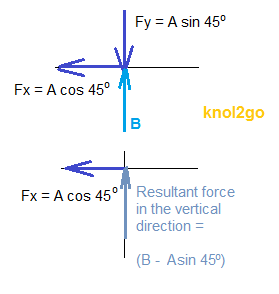
Resultant Force
As the name suggests, this is the force that is the result of
two, or more, forces acting on an object. As forces are vector
quantities, the forces cannot just be added by
only taking into account the magnitude (size). The directions of the forces have also to be
considered. If the forces are all in a straight
line, the addition (or subtraction) of the forces are straightforward,
which does not have to involve angles.
However, when the forces are not in a straight line, methods such as the triangle / parallelogram of forces and/or trigonometry can be used to determine the resultant force. In the example below, trigonometry is employed to help solve the resultant force of A and B.

Resolving force A into component forces in the vertical and horizontal directions:

Using the Pythagorean theorem, the magnitude of the resultant force can be calculated, and using trigonometry, the angle or direction (angle) can be determined.

However, when the forces are not in a straight line, methods such as the triangle / parallelogram of forces and/or trigonometry can be used to determine the resultant force. In the example below, trigonometry is employed to help solve the resultant force of A and B.

Resolving force A into component forces in the vertical and horizontal directions:

Using the Pythagorean theorem, the magnitude of the resultant force can be calculated, and using trigonometry, the angle or direction (angle) can be determined.


Contoh-contoh melibatkan daya paduan adalah seperti yang tertera di atas.
Sekira knol ini memanfaatkan anda, sila tekan Like dan Kongsikannya. Terima kasih.





